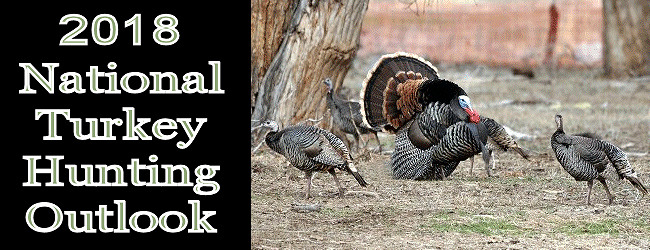The country's premier hunting and fishing daily news
The Backcountry Press
The Backcountry Outdoor News reports the latest hunting & fishing news along with fishing derbies & tournaments
from:
| ||||||
| ||||||
|
© 2010 Backcountry Press Outdoor News - All Rights Reserved
A18-2101
Disclaimer: The views expressed on this site are that of the authors and not necessarily that of The Backcountry Press Outdoor News
Connect With Us
National Spring Turkey Hunting Outlook for 2018
Submitted by: Backcountry Press Outdoor News
Posted on: 02/27/18
Loading
Here is a preview of the 2018 National Spring Turkey Hunting Outlook courtesy of Game & Fish Magazine, with links to read more. NOTE: Not all states with spring turkey hunting was included at the time of this report.
Hunters will want to check their state outlook before heading out for gobblers this spring. Also, hunters who are looking to get a Turkey Grand Slam will want to see whats happening around the country.
Alabama -- The status of the Alabama wild turkey population remains largely unchanged as the season opens, with overall turkey numbers being relatively stable compared with the past few years, along with localized areas of high turkey density and other spots with fewer birds.
“I think we’re still in good shape in terms of hunting,” said Steve Barnett, Wild Turkey Project leader for Alabama Wildlife and Freshwater Fisheries (WFF) and supervising biologist for District V in southwest Alabama.
The key is proper management, particularly practices that enhance nesting and poult rearing in the late spring and summer months. Properly managed tracts will likely house good numbers of turkeys. Acreage that is not managed with turkeys in mind will likely have fewer birds.
Despite the mixed numbers, Alabama turkey hunters can expect another good season with localized areas of high density in the bird population. READ MORE at 2018 Alabama Spring Turkey Hunting Outlook
Arkansas -- If you’re investing in Arkansas turkey hunting futures, diminishing returns suggest you should “Hold.”
By every measure, hunters should have killed more turkeys last year than in 2016, and the fact that it didn’t happen is cause for concern.
For many years, the Arkansas Game and Fish Commission has prescribed a 16-day spring turkey season that opened in late April and ended in early May. To the consternation of many hunters, the framework was designed to reduce the harvest of gobblers because it opened the season after most breeding activity was believed to have occurred.
What happened? Low turkey numbers appear to be the cause, said Jason Honey, the AGFC’s turkey program coordinator.
“Many factors, such as hen health, predators, illegal hen harvest, poor habitat and weather influence the number of turkeys in Arkansas,” Honey said. “Poor hatches during the last several years continue to suppress population levels across the state.” READ MORE at 2018 Arkansas Turkey Hunting Outlook
Florida -- Florida’s wild turkeys are well known for their tight-lipped demeanor, creeping through palmetto flats and oak hammocks upon unsuspecting hunters who thought their calling was in vain.
Public land wild turkeys rarely come easy. Fortunately, Florida offers millions of acres of public land throughout the state in which to pursue a gobbler. Some require limited-entry permits, while others require no permits but plenty of effort in order to succeed. Either way, bagging a mature tom is an accomplishment worth bragging about.
“Florida has the distinction of being the only state where the Osceola wild turkey is found and one of the earliest spring seasons to open, which brings turkey hunters here from across North America,” said Tammy Sapp with the Florida Fish & Wildlife Conservation Commission. “Hunters also pursue the Eastern subspecies north of the Peninsula and across the Panhandle.
Florida historically produces good turkey hunting opportunities where there are open forests, forest edges and openings. Florida continues to provide numerous hunting opportunities on public land throughout the state. FWC-managed public land turkey hunting opportunities include Special Opportunity hunts and Spring Turkey Quota permits, a type of limited-entry permit needed to turkey hunt on selected wildlife management areas. There are also opportunities to hunt on WMAs where a quota permit is not required.” READ MORE at 2018 Florida Spring Turkey Hunting Outlook
Georgia -- After several years of hunter and harvest numbers trending downward in Georgia, there was a small uptick in last season. In 2017, 50,694 hunters harvested 25,702 gobblers. The 25,702 gobblers killed in 2017 represent a 60 percent increase from the previous season, which was historically low. After several years of poor reproduction, the last two seasons had improved results.
There has been a disappointing trend in the last few years of declining hunter numbers. The competition for the interest of young hunters is intense. However there were nine percent more turkey hunters in 2017 than in 2016.
The state is divided into seven game management regions, each with its own geography, habitat and biologists. Statewide, the piedmont section in the middle of the state accounts for the highest percentage of harvest at 41 percent followed by the Upper Coastal Plain at 31 percent.
In the northwest portion of the state, the geography is ridge and valley around Rome. David Gregory, wildlife biologist, rates the forecast this season as fair. According to Gregory, Paulding Forest, Sheffield, McGraw Ford WMAs are best bets in this region. READ MORE at 2018 Georgia Spring Turkey Hunting Outlook
Kentucky -- Even though the weather is still pretty cold, many hunters are already gearing up for turkey season, gathering equipment and scouting to find birds. Thankfully, the Bluegrass State has a good population of North America’s largest game bird, as well as numerous locations where folks can hunt.
Last season, hunters took more than 33,000 birds in the commonwealth, which was a little higher than the previous two seasons of 31,000 and 30,800, respectively.
More hunters taking birds the last few seasons is certainly an indicator that the flock continues to be doing well as a whole.
Factors that directly affect the health of the population, such as spring weather conditions, fall mast production and hunting pressure were all normal in 2017, so poult production and winter survival was again good, according to biologists with the Kentucky Department of Fish and Wildlife Resources. READ MORE at 2018 Kentucky Turkey Hunting Outlook
Louisiana -- Hunters report hearing fewer gobblers and seeing birds less frequently even in prime turkey areas. Statewide, Louisiana turkey harvests declined over the past decade
“Based on frequent comments, it is quite evident that turkey hunters in Louisiana are increasingly concerned about declining turkey populations,” said Cody Cedotal, Louisiana Department of Wildlife and Fisheries Resident Small Game and Wild Turkey Program manager. “As an avid hunter myself, I am also concerned over what is, or more importantly is not, happening on the properties I hunt.”
Since 2005, the annual Louisiana turkey harvest declined by an estimated 43 percent while the number of hunters grew. Cedotal also reports declining reproduction rates in much of the state during the same period.
“These declines in harvest and production are indicative of declining turkey populations,” Cedotal explained. “Low turkey populations, combined with continued poor production, could have serious consequences for the future of turkey hunting in Louisiana.” READ MORE at 2018 Louisiana Turkey Hunting Outlook












